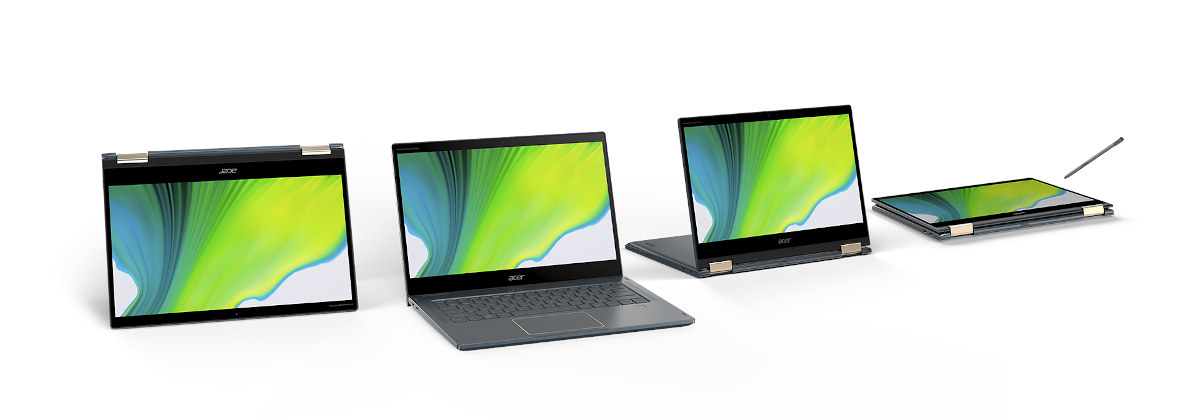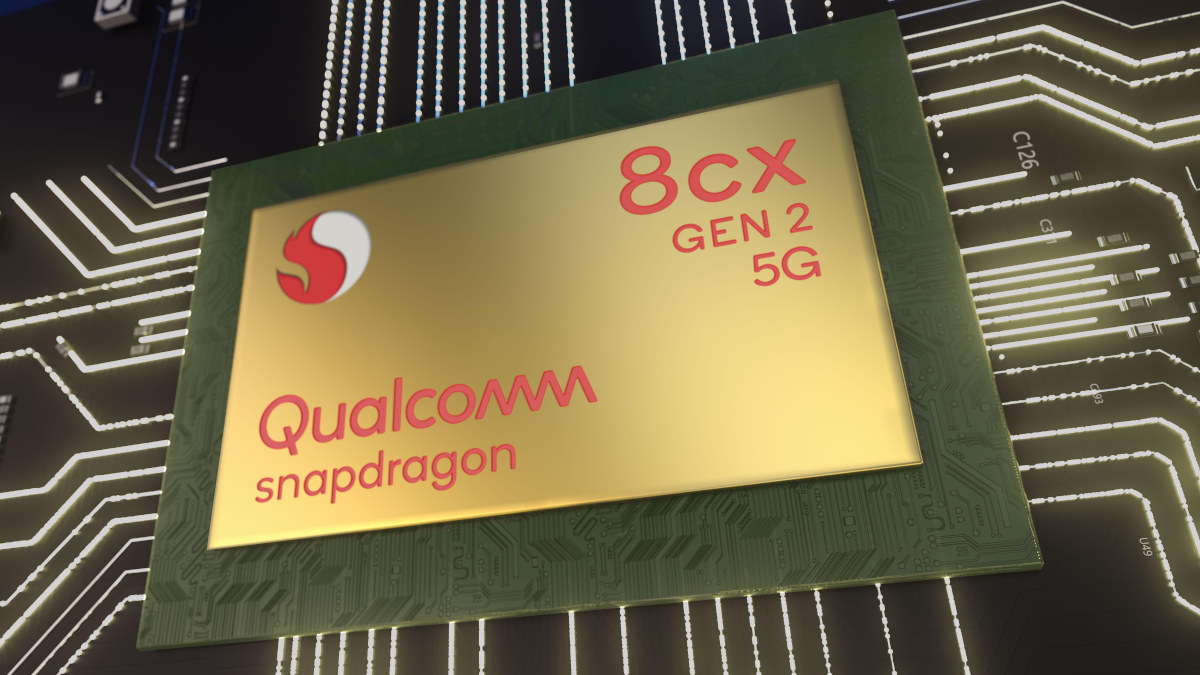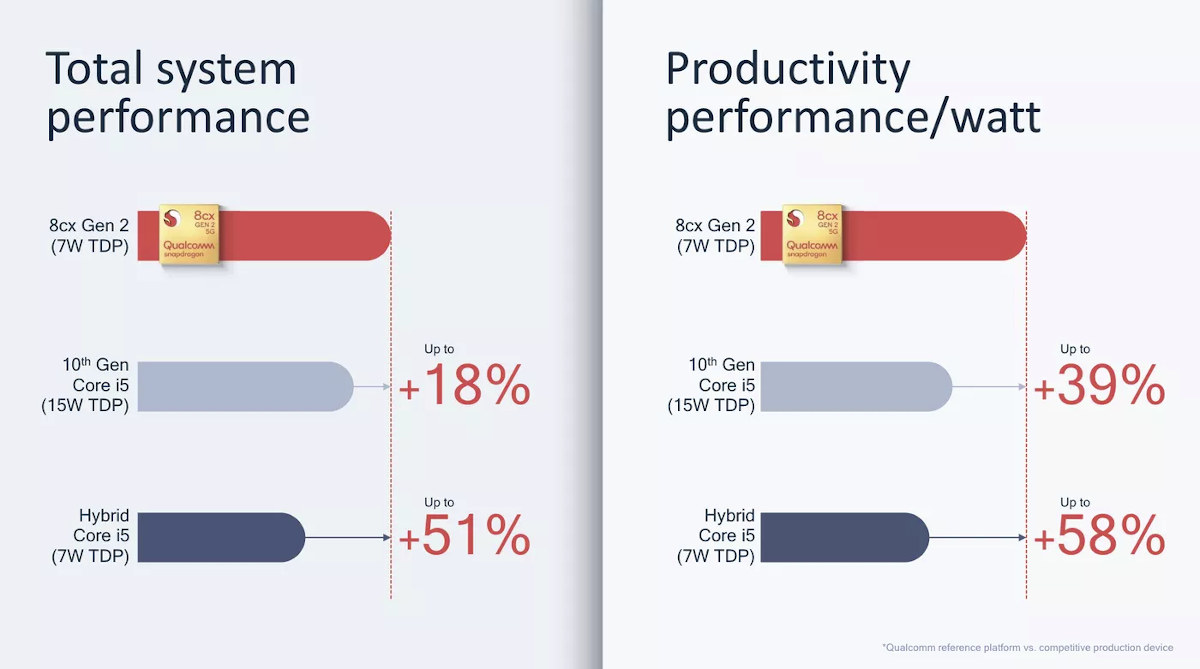Qualcomm Snapdragon 8cx 5G processor was launched last year for always-on always-connected PC and delivers a similar performance of 15W Intel Comet Lake processors with much lower power consumption enabling 20+ hours battery life.
The company has now an update with Snapdragon 8cx Gen 2 5G Compute Platform with 50% greater system-wide performance and battery life versus “competing solutions”. More on that later.
Snapdragon 8cx Gen 2 5G specifications with the differences against the first generation in bold or stricken-through:
- CPU – 8x Qualcomm Kryo 495 64-bit cores 7nm Process Technology
- Visual Subsystem – Qualcomm Adreno GPU with DX12 support
- Memory – LPDDR4x, 8 Channels up to 2133 MHz
- Storage – NVMe SSD, UFS3.0
- Qualcomm Artificial Intelligence Engine
- Qualcomm Hexagon 690 DSP (was 685)
- Qualcomm Sensing Hub technology
Qualcomm All-Ways Aware technology
- Display
- Maximum On-Device Display Support: 4K Ultra HD
- Dual 4K external displays support over DP-MST
- Audio
- Qualcomm Aqstic audio technology
- Qualcomm TrueWireless technology
- Qualcomm Broadcast Audio technology
- Qualcomm aptX audio technology: aptX Classic, aptX HD
Surround Sound AudioSpeaker Protection
- Camera
- Image Signal Processor: Dual 14-bit ISPs, Qualcomm Spectra 390 image
signal processor - 4K HDR video capture
- Single HFR 16 MPix camera at 60fps ZSL (Zero Shutter Lag)
- Dual 16 MP cameras
- Single 32 MP camera
- 4K HDR decode at 120fps
- Codec Support: H.265 (HEVC), VP9, and H.264
- Image Signal Processor: Dual 14-bit ISPs, Qualcomm Spectra 390 image
- Modems
- Qualcomm Snapdragon X55 Modem-RF System
- Peak Download Speed – 7 Gbps
- Peak Upload Speed – 3 Gbps
- Sub-6 GHz and mmWave
- Modes – FDD, TDD, SA (standalone), NSA (non-standalone)
- Qualcomm Snapdragon X24 LTE Modem Category 20
- Peak Download Speed – 2 Gbps
- Peak Upload Speed – 316 Mbps
- Supported Cellular Technologies: LTE FDD, LTE TDD including CBRS support, LAA, LTE Broadcast, WCDMA (DB-DC-HSDPA, DC-HSUPA), TD-SCDMA, CDMA 1x, EV-DO, GSM/EDGE
- Qualcomm Snapdragon X55 Modem-RF System
- WiFi
- WiFi Standards: 802.11ax (WiFi 6), 802.11ad, 802.11ac Wave 2, 802.11a/b/g, 802.11n
- WiFi Bands: 2.4 GHz, 5 GHz, 60 GHz
- MIMO Configuration: 2×2 (2-stream)
- Other Wireless Connectivity
- Bluetooth 5.1
Near Field Communications (NFC)- Location
- Global Emergency Services: Assisted GPS, OTDOA (LTE-based positioning)
- Satellite Systems: GPS, GLONASS, Beidou, Galileo, QZSS, SBAS
- USB – USB 3.1
- Charging – Qualcomm Quick Charge 4+ technology
The parts that are stricken-through are probably not removed from the chip, and simply not listed in the specs. The second-generation processor has virtually no visible differences except for support for a new Hexagon DSP, WiFi 6 connectivity, and the Bluetooth version has been bumped to 5.1. That’s probably why the company did not bother comparing Gen 1 vs Gen 2, and instead only offered charts comparing it to 7W and 15W Intel processors.
The 15W Intel Core i5 processor is probably a Comet Lake processor such as Intel Core i5-10210U, and the 7W Hybrid Core i5 is clearly an Intel Core i5-L16G7 Lakefield processor. Qualcomm Snapdragon 8cx Gen 2 5G is up to 51% faster than Lakefield processor, and 18% faster than the Comet Lake processor, while also offering higher efficiency.
The Acer Spin 7 will be the world’s first notebook powered by the Qualcomm Snapdragon 8cx Gen 2 5G compute platform. The laptop will feature a 14-inch FHD display, ship with a dockable Wacom AES 1.0 pen with 4,096 levels of pressure sensitivity, and weight around 1.4 kg.

More details may be found on the press release and product page.

Jean-Luc started CNX Software in 2010 as a part-time endeavor, before quitting his job as a software engineering manager, and starting to write daily news, and reviews full time later in 2011.
Support CNX Software! Donate via cryptocurrencies, become a Patron on Patreon, or purchase goods on Amazon or Aliexpress






